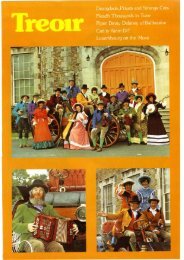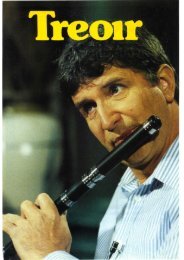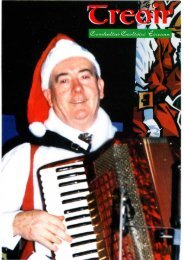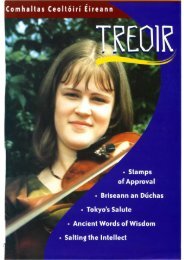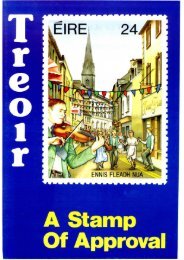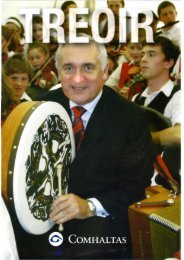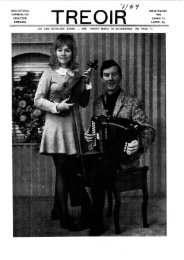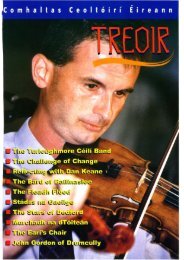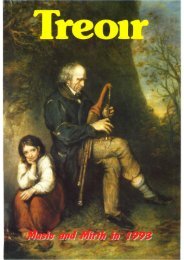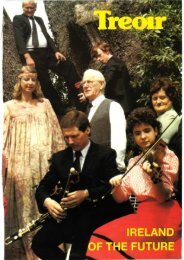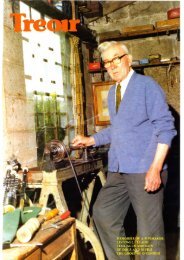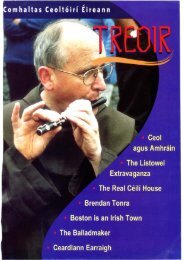You also want an ePaper? Increase the reach of your titles
YUMPU automatically turns print PDFs into web optimized ePapers that Google loves.
'Koltus' - 'Che Pied Piper<br />
of Sardinia<br />
L\lison Fottrell<br />
Alison Fotrell is fro m Dublin, Ireland. She has been working as an<br />
English teacher since landing in Milan in Jun e 1996<br />
lgrave Sq uare, D ublin ...<br />
home of Koltus Ireland ... the :1 7J; Pied Pi per of the Irish musical<br />
trad ition w hich has tread a path across<br />
the worl d, gathering followers and fa ns<br />
in its wake .<br />
The piper Enz o Burbello and the<br />
Launeddas player Roberto Corona in<br />
Cagliari<br />
Belgrave Sq uare, Sardinia ... hea rt of<br />
Ko ltus Ita ly ... a group of Ita lian<br />
musicians w ho beat out the rh ythms of<br />
Ire land w ith a passion and love for Irish<br />
music and culture. Ko ltus, short for<br />
<strong>Comhaltas</strong> Ceolt6 irf Eirea nn , was<br />
founded in Dublin in the Spring of 195 1 .<br />
Its mission was to promote and preserve<br />
the Irish musica l tradition in an<br />
atmosphere of changing soc ial trends. At<br />
the turn of th.e century, Irish trad itional<br />
music was favoured by the vast majority<br />
of Iris h peopl e. People in th e<br />
countryside regularl y gathered to pass a<br />
night of song and dance at any suitabl y<br />
located house in the area. The lively<br />
footwork of dancers tapped out intricate<br />
rhythms on flagstone farmhouse floors,<br />
supported by musicians w ho, through<br />
th eir w illingness to play, availed of an<br />
open invitation to such 'soirees'. Cities<br />
such as Dublin and Belfast likewise had<br />
trad itional music communities w here<br />
provincial immigrants compared and<br />
swapped tunes w ith the 'natives'.<br />
Although the jaws of emigration in the<br />
1920s, 1930s and 1940s attempted to<br />
devour Ireland 's youth, the Irish musica l<br />
trad ition consequently flourished among<br />
emmigrants in the cities of England and<br />
the USA . The most ce lebrated of all Irish<br />
trad itional fiddlers, Michae l Coleman,<br />
record ed more than 60 records in New<br />
York during this peri od. However on the<br />
home front, jigs and reels of the ceilf<br />
house were being replaced by the far<br />
more enticing foxtrots and ta ngos of the<br />
'ba llrooms of romance' . It was this<br />
sophisti cated soc ial scene w hich placed<br />
the nati ve Irish music and trad itions in<br />
danger of extincti on. Desp ite th e<br />
th ousa nds of traditional musicians in the<br />
th e country at the time, their morale was<br />
low due to the lack of appreciati on for<br />
th ei r music in the intellectual and<br />
'trendy' circles of Irish society. While<br />
dust gathered on many fiddles and flutes,<br />
a group of determined young musicians<br />
w ho regularl y met at the Pi pers Club in<br />
Dublin made contact w ith fe llow<br />
enthusiasts all over Ireland. Togetherthey<br />
planned the first 'Fl ead h Cheoil' or 'Feast<br />
of M usic' which took place in 195 1. And<br />
thus w as born th e tra di tional music<br />
organi sati on <strong>Comhaltas</strong> Ceolt6irf Eirea nn<br />
or Fellowship of Musicians of Ireland.<br />
Through the organisation of competitions,<br />
the Fleadh Cheoil set out to establish<br />
standard s in Irish traditional music. Today,<br />
nearl y fifty years later, th ese 'Feasts of<br />
Music' provide a meeting place for the<br />
many young musicians w ho carry on the<br />
great tradition of Irish music and dance.<br />
Day time competitors coll aborate in night<br />
time sessions and the 'craic' and 'ceol'<br />
continue into the earl y hours.<br />
Lia Luachra with Enzo Burbello,<br />
Gianluigi Puddinu, Elide Conciatori,<br />
Gianluca Dessl, Mariagrazia Mam as,<br />
and Italo Siddu of the Sardinian<br />
Branch of <strong>Comhaltas</strong>.<br />
Lia Luachra in Cag/iari<br />
Hav ing already survived th e industria l<br />
revolution and post war pop culture, the<br />
fo rm ati on of Koltus gave traditional<br />
music ians a platform from w hich they<br />
cou ld play to an audience w ho<br />
appreciated the rea l beauty and va lue of<br />
their music. Th roughout the 1950s the<br />
Fl ead h and Ko ltus grew hand in hand.<br />
Branches of Koltus sprang up all over<br />
Ireland organising classes, concerts and<br />
sess ions.<br />
Instruments<br />
Any impromptu sessions at the nearest<br />
Fl eadh Cheoil or local bar necessitates a<br />
fiddle and a tin w histl e, w ith popul ar<br />
additions of banjos, two row accordions<br />
and flutes. The concertina or 'squeeze<br />
box', piano accordion and mandolin are<br />
less w idely played w ith the exception of<br />
County Clare in the west of Ireland w here<br />
the concertina is a popul ar choice,<br />
particularl y among female musicians. The<br />
bodhran, a simple hand-held goatskin<br />
drum, gives deeper rhythm to the music<br />
but one may also fi nd the rh ythms being<br />
tapped out w ith a pair of bones or spoons.<br />
q



